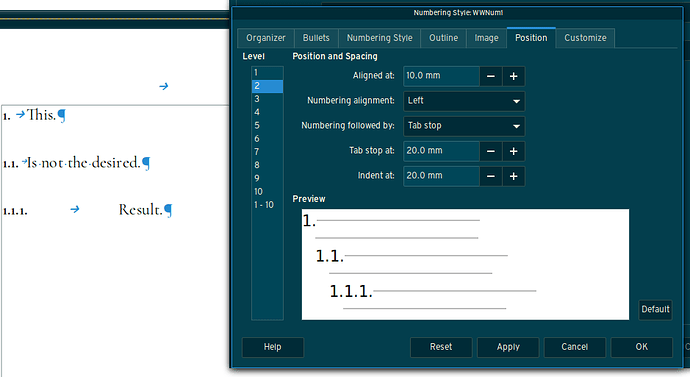There is not enough information in your question to give the right answer.
From the screenshot, it appears your document is a .doc(x) or has been converted from M$ Word (the list style is named WWNum1). Depending on how you typed the text shown (new list created with toolbar buttons or modified an existing list), your list may be under WWNum1 control or under default settings control.
The best thing you can do ios to attach your file to the question (don’t start a conversation only to provide additional details, edit your question; this is much better for clarity and conciseness).
EDIT CAUTION! CAUTION! CAUTION! CAUTION!
I am afraid you’re heading in the wrong direction. When you convert an M$ Word document into LO Writer a lot of nuisances happen. M$ Word is rather rudimentary in its style management: it knows of only paragraph styles. All other formatting is done as direct formatting in Writer parlance. This means Writer has a lot of work trying to guess which formatting was at stake. And to avoid possible future mess in the document, it creates many many many (should be written 77 times) single-use character and page styles. This means you can’t manage smartly the resulting formatting. Everything is polluted because of the shortcomings in Word design.
You apparently talk about a Word “template”. If this is what you are doing: converting a template, you should rather start from a blank document and redesign the template from scratch in Writer concepts. Don’t open your Word template in Writer because a conversion will take place and bring its tons of distortions. Of course, you can open the template as a reference but don’t edit it in the hope of using it afterwards lest the pollution will be transferred to every document based on the template.
Think about the goal of every piece of data in the template and implement it in Writer features. Think about the importance of character and page styles which do not exist in Word.
And warn your colleagues about their use. Encourage them to character-style their documents instead of direct formatting them (e.g. bold, italics, …). Also try to adopt best practice: styles should not be named for their effect (e.g. “Bold with red”) but for their significance (e.g. “Very strong emphasis”). Take inspiration from the built-in style names. Thus Emphasis can be changed from italics to not-italic+blue and the name Emphasis is still semantically valid while changed Bold is no longer mnemotechnic.

